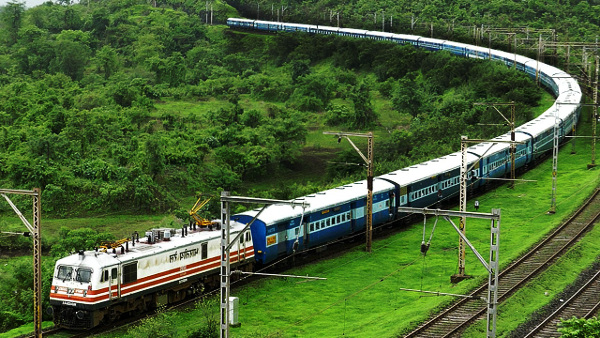North Eastern Railway, which is predominantly a passenger-oriented system, has established itself as one of the leading zones in providing safe, secure, faster, more comfortable, and dependable public transportation in the year 2021.
1. Infrastructure Developments: During 2021, the following new projects have been commissioned:
Gauge Conversion of 47km: Shahjahanpur – Shahbaznagar (4km) and Mailani – Shahgarh (43 Kms).
- Doubling and electrification of 101 km:
- Aunrihar-Ghazipur City (40 Kms)
- Sitapur-Parsendi (16.8 kms)
- Madhosingh-Gyanpur Road (14.6 kms)
- Ballia-Phaphna (10.5 kms)
- Aunrihar-Dhobhi (20 kms).
- Electrification of 406 km.
- Coach maintenance facilities have been set up at Ballia and Ghazipur.
- 6 ROB have been completed.
2. Passenger Amenities:
- 24 escalators have been provided at 10 different stations.
- 22 lifts have been provided at 8 different stations.
- 47 Railway stations have been developed in to Adarsh stations.
- Wi-Fi provided in all the 295 eligible stations.
3. Safety:
- Many safety precautions have been implemented to reduce the number of unfavourable incidents, with a particular focus on failure investigations and other remedial steps to prevent such occurrences.
- The installation of RUB/LHS/ROB and diversions has eliminated 75 level crossings.
- Every level crossing gate with a total vehicle unit (TVU) of more than 50,000 has been interlocked. In addition, 16 Level Crossing gates with a TVU of less than 50,000 were linked in 2021.
- The track was renewed for 78 kilometres. Aside from that, 192 km of plain track and 145 turnouts were deep-screened.
4. Loading:
- When compared to the same period last year, the cumulative loading has increased by roughly 60%.
- To boost loading, 26 major goods sheds have been made operational for round-the-clock operation, and the average speed of goods trains has been increased and constantly maintained over 50 km/h for the entire year.
- With the help of Business Development Units (BDU) at the Zonal and Divisional levels, 22 Kisan Rail rakes have been loaded and operated from Izzatnagar division’s Farrukhabad railway station to the North East Frontier Railway.
- Last year, NER began a relatively new stream of traffic: automobile loading. This year, 113 rakes of autos were loaded from Haldi Road, representing a 41% increase in loading.
- Two major automobile handling terminals have been built, one at Bakshi Ka Talab and the other at Nautanwa, both of which are serving the transportation needs of Nepal. At these sites, 77 rakes were unloaded.
- 550 condemned ICF coaches were rebuilt into NMG waggons in Gorakhpur and Izzatnagar workshops to ease automobile loading. This is the year’s largest conversion on Indian Railways.
5. Expenditure Control:
- GEM has contracted out station cleaning, on board housekeeping services (OBHS), and mechanised cleaning to save money. A total of ten contracts have been completed, resulting in savings of more than 40%.
- Railwaymen have been properly taught and equipped to perform numerous maintenance tasks that would otherwise be performed through annual maintenance contracts (AMCs), thus stopping the reduction in railway income.
- The facility of oxygen plants has been installed in all zonal and divisional railway hospitals, resulting in a 70 percent reduction in medical oxygen cost.
- These measures are estimated to save a total of 20 billion dollars.
6. Energy Conservation:
- More than 75% of NER routes have been electrified and this would become almost 100% electrified railway by the end of the year 2022.
- After electrification of main routes, the expenditure on high speed diesel (HSD) has been considerably reduced, registering a saving of Rs. 361 Crores.
- CUF (Capacity Utilization Factor) based solar monitoring system has been implemented which has resulted in 26% higher solar energy generation this year as compared to corresponding period of last year with the same installed capacity of 4.72 MWp.
- Total 31 pair of trains which originate/terminate on North Eastern Railway are running on HOG system.
- NER won first prize in transportation category under the prestigious National Energy Conservation Awards – 2021.
- Under UP NEDA awards 2021, Gorakhpur station won first prize under commercial building category, Gonda station won second prize under government building category, Izzatnagar workshop won second prize in Industrial category and DRM office, N.E. Railway, Lucknow won third prize in government building category.
- Water recycling systems with a capacity of 700KLD per day have been installed at four locations.
7. Customer Satisfaction:
- Rail Madad’s disposal time has been cut to 13 minutes, down from 3 hours and 6 minutes last year, thanks to regular monitoring and decisive action. On Indian Railways, this is the quickest disposal time.
- It is noteworthy that the quality of corrective activity did not suffer as a result of the shorter disposal time. The average customer satisfaction rating is very high.
- In the Railway Board’s Rail Madad measures, NER has the highest score.
Complaints received through CP GRAMS are also handled in a similar fashion, with a one-day turnaround time compared to 11 days last year. On Indian Railways, it is the quickest disposal time.
You may also like
-
Dot Simplifies Approval Processes For Telecom Licenses And Wireless Equipment
-
PM to Inaugurate SEMICON India 2024 on 11th September
-
Shri Piyush Goyal Sets 500 Million Tonnes Domestic Steel Production Target by 2034
-
NHAI to Track Around 100 Toll Plazas with GIS-Based Software for Seamless Movement of Traffic at National Highways
-
“Marching Towards Building A Digitally Connected Bharat and An Atmanirbhar Telecom Sector”: Union Minister Jyotiraditya Scindia
